High-Frequency Oscillatory Ventilation Monitoring Method and System
a high-frequency oscillatory and monitoring method technology, applied in the field of monitoring artificial ventilation, can solve the problems of easy blockage of tubing, easy movement out of place, and inability to meet the needs of premature babies,
- Summary
- Abstract
- Description
- Claims
- Application Information
AI Technical Summary
Benefits of technology
Problems solved by technology
Method used
Image
Examples
Embodiment Construction
[0020]FIG. 1 depicts a method 10 of monitoring high frequency oscillatory ventilation (HFOV) according to an embodiment of the present invention wherein the oscillatory movement of the chest wall of an individual is measured 20. The individual may be an animal. The individual may be a neonate. HFOV forces air into and out of the lungs of the individual, and such activity causes movement of the chest wall as the lungs expand and contract with air volume. This movement is oscillatory—an oscillator causes air to enter and then exit the lungs repeatedly. The frequency of the oscillation is determined by an operator of the oscillator and is fixed insofar as lung compliance does not affect the frequency. The frequency may be set at, for example, twice the rate of the individual's heart beat. The frequency may be as high as 900 oscillations per minute or higher.
[0021]The chest wall excursion is measured by an accelerometer, which measures the acceleration of the chest wall to determine the...
PUM
 Login to View More
Login to View More Abstract
Description
Claims
Application Information
 Login to View More
Login to View More - R&D
- Intellectual Property
- Life Sciences
- Materials
- Tech Scout
- Unparalleled Data Quality
- Higher Quality Content
- 60% Fewer Hallucinations
Browse by: Latest US Patents, China's latest patents, Technical Efficacy Thesaurus, Application Domain, Technology Topic, Popular Technical Reports.
© 2025 PatSnap. All rights reserved.Legal|Privacy policy|Modern Slavery Act Transparency Statement|Sitemap|About US| Contact US: help@patsnap.com



